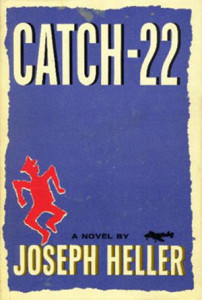| Title: | Nineteen Eighty-Four |
| Author: | George Orwell |
| Publisher: | Secker & Warburg |
| Location: | London, United Kingdom |
| Published: | June 8, 1949 |
| Genre: | Literature, Political Fiction, Science Fiction |
| Pages: | 312 |
| Price: | 10s |
| Print Run: | 26,575 |
Catch-22 is a novel by Joseph Heller, published by Simon & Schuster in 1961.
First Edition Identification Points
All of the following points must be present to ensure a true first edition / first printing.
- The copyright page has the following text: “FIRST PRINTING”
- The copyright page also has the following text:
LIBRARY OF CONGRESS CATALOG NUMBER: 61-12846
MANUFACTURED IN THE UNITED STATES OF AMERICA
BY H. WOLFF BOOK MANUFACTURING CO., N. Y.
- Front flap of dust jacket has price $5.95 at the bottom right
- Front flap of dust jacket has synopsis that starts “CATCH-22 is like no other novel…”
- Neither flap of dust jacket has review excerpts
- Back flap of dust jacket lists “Author’s photograph by Seymour Linden” in red at the bottom
- Back cover of dust jacket has a full page photograph of Joseph Heller with no text
Later Editions’ Identification Points
The applicable printing numbers are listed in brackets when known.
- The copyright page replaces the text “FIRST PRINTING” with the applicable number. For example, the second printing lists “SECOND PRINTING” [2+]
- The back cover photo is no longer full page; a text block is added on the bottom starting “Joseph Heller is thirty-eight years old…” [6+]
- Both flaps of dust jacket now have multiple review excerpts “In praise of Catch-22” and different synopsis [6+]
- Back flap no longer has “About the Author” section as that information has moved to the back cover [6+]
- The copyright page no longer has the line “BY H. WOLFF BOOK MANUFACTURING CO., N. Y.” [7+]
Book Club Editions’ Identification Points
- The copyright page has no mention of print number, Library of Congress number, or Wolff Book Manufacturing Co.
- Front flap of dust jacket has no price listed and Book Club Edition at the lower right
- Back flap of dust jacket lists “PRINTED IN THE U.S.A.” and “1935” in the bottom middle
Publication History
Joseph Heller had considered writing a novel about a flier towards the end of his missions as early as 1946. Heller himself had served as a bombardier in World War II, flying 60 missions. On top of that fact, the author has offered numerous origin stories that contributed to the genesis of the novel. In one story he said that he was influenced by two friends who had each been wounded in the war; one of whom joked about the experience and the other found no humor whatsoever in it. The writer Arnošt Lustig recalled that Heller told him Catch-22 wouldn’t have been written if he hadn’t read The Good Soldier Švejk first. Heller repeatedly told the story of being struck by inspiration with the opening lines of Catch-22 while lying in bed in his apartment in New York, and the rest of the novel evolving quickly from there. At that point (in 1953) he was working at an advertising firm, and the next morning in the office he jotted down the first chapter in a 20-page manuscript entitled “Catch-18”.
He sent the manuscript to an agency where a woman named Candida Donadio discovered it. She was impressed and began sending it around. The initial reaction was tepid, but eventually the piece came to the attention of the editor for New World Writing, Arabel J. Porter, who would publish “Catch-18” in the No. 7 issue in April 1955 (alongside a chapter from On The Road by Jean-Louis “Jack” Kerouac). Donadio (at age 24) became Heller’s agent and the author continued revising and expanding upon the work for the next few years. In August 1957, she sent a 75-page draft (Heller had initially envisioned the work as a novella) to Simon & Schuster for consideration. By February of 1958, the manuscript had grown to 259 pages across seven chapters. Robert Gottlieb, a young executive at the company, became a champion of the work despite its offensive nature, or perhaps because of it. He believed it would become a prestigious title even if it did not sell well, and the board deferred to him. Simon & Schuster offered Heller a standard contract: $750 up front and $750 upon completion of the manuscript, with 1960 as the intended publication year.
1960 came and went, and the novel was still growing and changing. Heller was a chronic tinkerer. Whole chapters were added, removed, or changed places in the various drafts, which he worked on concurrently. When it became apparent that author Leon Uris was about to release a World War II novel called Mila 18, the team decided they needed a name (number) change. The next option they liked was “Catch-11” but the film “Ocean’s Eleven” had just come out. Heller liked the number 14; Gottlieb did not. Finally they decided on “Catch-22” which had a nice alliterative, repetitious quality (and Donadio would claim it had to do with her birthday on October 22nd). At this point Heller had shed hundreds of pages from a massive 758-page version of the novel and had finally settled on the printer’s copy. Simon & Schuster (and specifically Nina Bourne) wrangled up a number of pre-publication positive reviews before the 443-page book was released on October 10th, 1961 for $5.95. Bourne had also pleaded for the print run to be expanded from the standard 5,000 to 7,500 based on her conviction that the book was a hit. Reactions were decidedly mixed upon the Catch-22‘s release, but an aggressive ad-campaign and positive word-of-mouth expanded the novel’s fanbase. It was an immediate best-seller in Britain and the paperback did extremely well, selling over a million copies in six months.

